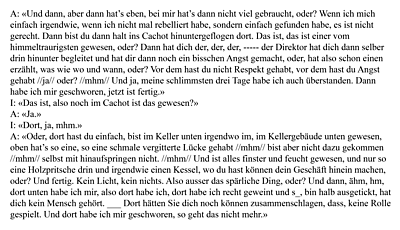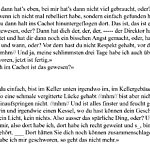Solitary confinement - personal accounts on life in detention
 Excerpt from an IEC interview transcript, H. Ge.-Gr. (pp. 27-28)
Excerpt from an IEC interview transcript, H. Ge.-Gr. (pp. 27-28) RESEARCH QUESTIONS
The perspectives of the individuals who were subject to administrative detention orders are an important element of the IEC’s research. Thus far some 50 interviews have been conducted with former detainees, in the course of which they were also asked about their experiences in the detention facilities. These personal accounts make it possible to obtain insight into what daily life was like in the different institutions, information that may not (necessarily) be found in the official records. The interviews can provide answers to such questions as the following, for example: What kind of work were the inmates required to perform? What was the food like? What rules had to be obeyed in the detention facility and how was disobedience punished? What did the facility staff or the guards do, and how did they behave towards the detainees? Etc.
In addition to such more general questions on life in detention, analysis of the interviews also focusses particularly on the individual experiences of the detainees and how they came to terms individually with the circumstances of their being held in administrative detention. How did the detainees deal with their situation? What was it like, and how did they cope with being deprived of their liberty, with being punished, or with violence in the detention facilities? In the case of the source here presented, for example, there is the question of how it was possible to cope with the extreme situation it describes (that is, a situation of severe psychological and physical stress). How did the individual in question manage to get through such a difficult period? What does he mean when he says «that’s it», or «this has got to stop»; what kind of turning point does this suggest? What are inner resources that the individual can mobilise to cope with such situations? What (survival) strategies are developed? Etc.
Finally, the IEC is interested in the full biography of the individual who was subject to an administrative detention order and seeks to find out more about such things as the long-term consequences of experiences such as those described in the source, the way they affected the later course of his life.
USE OF THE SOURCE
The interviews are analysed using the recognized methodologies of qualitative social research (grounded theory, objective hermeneutics). To begin, a full and precise (literal) transcription of the interviews is prepared. These literal transcripts are essential in order to proceed systematically with the analysis of the interviews. Important information for the analysis of the interviews would be lost if they were to be studied only by listening to the audio recordings or using summaries of the content.
Each of the interviews is first analysed individually. After that, they are compared with other interviews in order to identify similarities and differences in the accounts of the former detainees. In this way it is possible to describe the various types of experiences that detainees had in the facilities and the different courses their lives took after their release. The intention is to present individual case studies as well as more general findings in the form of a «typology» of experiences or a «collective biography».
PARTICULARITIES OF THE SOURCE
The literal transcription of a spoken text can initially be somewhat disconcerting for the reader and can take time to get accustomed to. The reader must try not to be distracted by the numerous incomplete sentences, repetitions, odd formulations, grammatical errors and the like. Such features are typical of spoken language and do not necessarily imply anything about the speaker’s linguistic capabilities. The source here presented illustrates how much more expressive a literal transcription is than a mere summary of the content. The breaking off of sentences, the repetitions and the pauses give an idea of the emotional strain that the interviewee is under. In addition, it is only by means of a literal transcription of the interviewees’ statements that it becomes possible to genuinely take into account the individual perspective of the person concerned. Only by considering the way in which the events are retold does their meaning for the individual concerned – as a turning point in their lives, for example, as suggested by the use of the phrase «that’s it» – become manifest.
A. Schwendener/Translation
source
Excerpt from an IEC interview transcript, H. Ge.-Gr. (pp. 27-28).
 previous source
previous source


